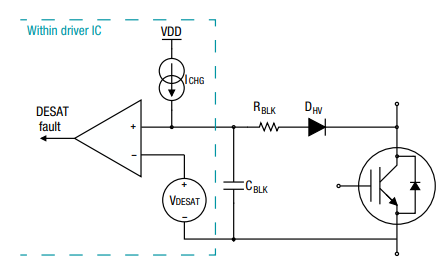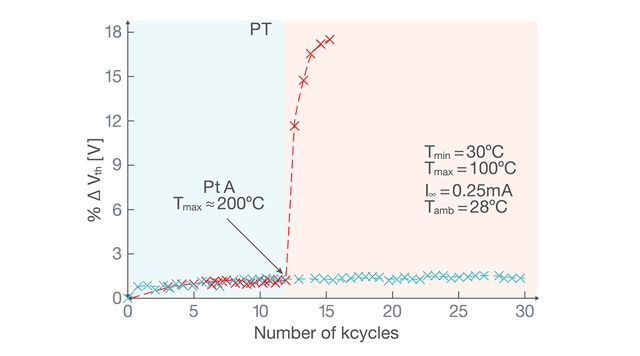SSZT051 december 2022 UCC5870-Q1 , UCC5880-Q1
This article originally published in Electronic Products.
Electric-vehicle designers can increase the safety and reliability of traction inverter systems by monitoring the gate voltage threshold.
When a consumer purchases a vehicle, they assume that the design engineers did their due diligence to create a safe product. In order to achieve a necessary level of safety, especially in regard to International Organization for Standardization (ISO) 26262 standards, subsystems within a vehicle such as the traction inverter must include internal diagnostics and protection features to help detect potential failure modes.
An inverter subsystem that receives a lot of attention is the power stage. Aside from the power module, the power stage includes integrated semiconductor devices such as the isolated bias supply, gate drivers, and power switches. The switching scheme of the module helps transfer DC power from the battery into AC power to drive the electric vehicle’s motor efficiently and reliably. When driving these power switches, there are several reasons to monitor their status or condition and different methods for doing so.
Importance of Switch Protections and Diagnostics
Because silicon carbide (SiC) metal-oxide semiconductor field-effect transistor (MOSFET) or insulated-gate bipolar transistor (IGBT) power modules are so important to a vehicle’s operation and efficiency, designers must carefully consider how to drive them correctly. Implementing a comprehensive failure-mechanism analysis is necessary to create a safe and reliable product.
An inverter system has to handle a long list of fault scenarios. For example, a short-circuiting power switch may indicate that the power switch has reached its end of life. When current through the power switch increases past its rating, the dissipation of excess power and heat through the device could destroy both the power switch and the inverter system. It’s important to detect and address this situation as quickly as possible to keep a power switch within its safe operating area.
The most common protection circuit designed to detect this type of fault is called desaturation (desat) protection, which can be integrated within a gate driver. Figure 1 shows the implementation of a typical desat circuit, which monitors a switch’s on-state voltage (the collector-emitter voltage [VCE] in IGBTs or the drain-to-source voltage [VDS] in SiC FETs) to detect a preset threshold (VDESAT). A condition in which VCE or VDS is greater than VDESAT triggers desat, and the gate driver will safely shut down the IGBT or SiC FET to prevent damage to the switch.
 Figure 1 Typical Desat Circuit Implementation
Figure 1 Typical Desat Circuit ImplementationAnother scenario is when the gate driver’s output doesn’t match its input signal; this irregularity requires immediate detection so that the inverter system can shut down safely. Including a gate-voltage–monitoring function to detect whether the gate voltage is at the same level as the input signal coming into the output die can help determine whether there is a fault in the communication lane or isolation barrier. The implementation of advanced protections and diagnostics helps establish a high degree of safety and reliability in a vehicle.
Why VGTH Monitoring Matters
The inverter system’s goals and requirements ultimately determine the diagnostics and protections designed into it. Including gate voltage threshold (VGTH) monitoring into the design is an important measurement to help evaluate the state of the power module’s health throughout its lifetime. In their paper “Analysis of Vth Variations in IGBT Under Thermal Stress for Improved Condition Monitoring in Automotive Power Conversion Systems,” Syed Huzaif Ali and Bilal Akin showed that significant variation of VGTH over time is an early indicator of power-switch failure.
Figure 2 shows two devices subjected to high-temperature power cycling. At the point when the device represented by the red curve is subjected to an increased temperature, it fails and the threshold voltage dramatically rises. Although this voltage rise is a failure event, the gradual shift of threshold voltage over time can also result in unwanted switching behavior, such as increased switching losses, which could indicate the need for vehicle maintenance. In general, VGTH monitoring helps prevent catastrophic failure.

Source: “Analysis of Vth Variations in IGBT under Thermal Stress for Improved Condition Monitoring in Automotive Power Conversion Systems”
Figure 2 Percentage Change in VGTH after Thousands of CyclesOne Method for Monitoring VGTH
The ISO 26262–compliant UCC5870-Q1 isolated gate driver from Texas Instruments integrates a novel VGTH-monitoring feature in which the gate driver checks its respective power switch’s health. Integration of this diagnostic into the gate driver reduces overall system size, weight, and cost compared with a discrete implementation.
The VGTH-monitoring function measures the gate threshold voltage of the power transistor during power-up. A constant-current source charges the gate capacitance (CG) of the power switch, which causes the gate voltage (VG) to gradually increase. Once the channel starts conducting, VG is naturally held at the threshold voltage (VGTH) level while the power switch is in a diode configuration.
After a blanking time (tdVGTHM), the integrated analog-to-digital converter samples the VG and stores the measurement in a register. The microcontroller uses this measurement to judge the health of the power switch. Monitoring VGTH helps confirm that the power stage is reliable.
Conclusion
Because vehicle electrification is relatively new to car consumers, they may have concerns about hybrid or electric vehicles being safe and reliable alternatives to internal-combustion–engine vehicles. Including sufficient internal diagnostics and protections helps ensure that a vehicle is suitable for market release and deployment on the road.
Additional Resources
- To learn about driving IGBT and SiC power switches, see the e-book IGBT & SiC Gate Driver Fundamentals.
- Download the UCC5870-Q1 gate driver data sheet.
- To learn about designing isolated gate drivers in a traction inverter system, check out the application report HEV/EV Traction Inverter Design Guide Using Isolated IGBT and SiC Gate Drivers.
- To learn about designing a traction inverter with a distributed architecture, read the technical article Driving Next-Generation EV Systems With a Distributed Architecture.